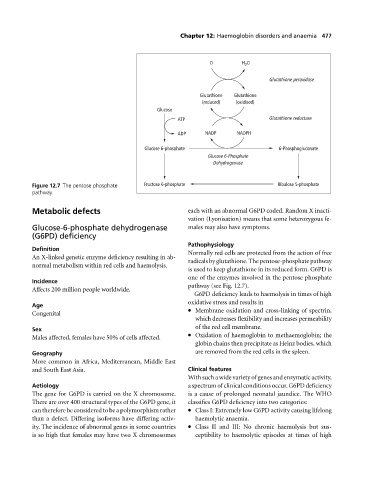Page 481 - Medicine and Surgery
P. 481
P1: KOA
BLUK007-12 BLUK007-Kendall May 12, 2005 20:37 Char Count= 0
Chapter 12: Haemoglobin disorders and anaemia 477
O H 2 O
Glutathione peroxidase
Glutathione Glutathione
(reduced) (oxidised)
Glucose
ATP Glutathione reductase
ADP NADP NADPH
Glucose 6-phosphate 6-Phosphogluconate
Glucose 6-Phosphate
Dehydrogenase
Figure 12.7 The pentose phosphate Fructose 6-phosphate Ribulose 5-phosphate
pathway.
Metabolic defects each with an abnormal G6PD coded. Random X inacti-
vation (Lyonisation) means that some heterozygous fe-
Glucose-6-phosphate dehydrogenase males may also have symptoms.
(G6PD) deficiency
Pathophysiology
Definition
Normally red cells are protected from the action of free
An X-linked genetic enzyme deficiency resulting in ab-
radicals by glutathione. The pentose-phosphate pathway
normal metabolism within red cells and haemolysis.
is used to keep glutathione in its reduced form. G6PD is
one of the enzymes involved in the pentose phosphate
Incidence
pathway (see Fig. 12.7).
Affects 200 million people worldwide.
G6PD deficiency leads to haemolysis in times of high
oxidative stress and results in
Age
Membrane oxidation and cross-linking of spectrin,
Congenital
which decreases flexibility and increases permeability
of the red cell membrane.
Sex
Oxidation of haemoglobin to methaemoglobin; the
Males affected, females have 50% of cells affected.
globin chains then precipitate as Heinz bodies, which
Geography are removed from the red cells in the spleen.
More common in Africa, Mediterranean, Middle East
and South East Asia. Clinical features
With such a wide variety of genes and enzymatic activity,
Aetiology aspectrum of clinical conditions occur. G6PD deficiency
The gene for G6PD is carried on the X chromosome. is a cause of prolonged neonatal jaundice. The WHO
There are over 400 structural types of the G6PD gene, it classifies G6PD deficiency into two categories:
can therefore be considered to be a polymorphism rather Class I: Extremely low G6PD activity causing lifelong
than a defect. Differing isoforms have differing activ- haemolytic anaemia.
ity. The incidence of abnormal genes in some countries Class II and III: No chronic haemolysis but sus-
is so high that females may have two X chromosomes ceptibility to haemolytic episodes at times of high

